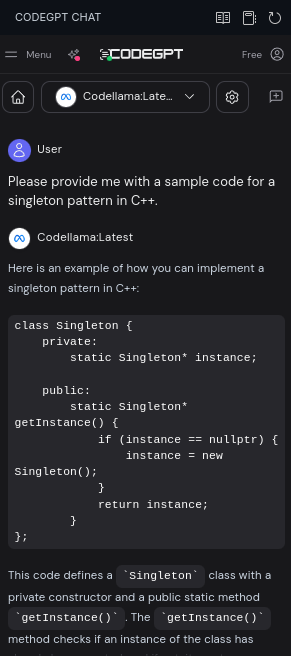Introduction
In our latest article, we explored how to install and configure Ollama, a state-of-the-art tool that streamlines the deployment of large language models and interactions with them. We were able to understand the basic functionalities of this software and harness some of its potential, by also taking a look at its API endpoint.
Today, we continue our investigation by delving deeper into the unexplored potential offered by Ollama’s versatile API. By exploring real-world applications that demonstrate seamless integration across multiple platforms, we aim to showcase how this tool can bring about groundbreaking improvements in efficiency, productivity, and overall user experience. From customer service solutions to content generation tools, we endeavor to demonstrate the far-reaching impact of Ollama’s API.
Potential Integrations
In this section, we present several examples of real-world applications where Ollama can be seamlessly integrated to bring about unprecedented improvements in efficiency, productivity, and overall user experience across multiple platforms. We will focus in four different integrations, that we think deserve some highlighting.
Docker

Docker is a containerization platform that simplifies software development by packaging applications with all necessary dependencies into lightweight, portable containers, ensuring consistency and simplicity in deployment across various environments. Use cases include streamlined deployment, reduced resource consumption, improved collaboration, scalability, flexibility, and continuous integration/continuous deployment (CI/CD).
Docker and Ollama integrate to create a streamlined development environment for large language models, enabling developers to package their applications with all necessary dependencies. Alongside this, the Ollama team has anncounced that there even is an official docker package for Ollama, specifically simplifying the installation process of docker containers running ollama.This allows user to setup, create and run docker containers specifically for running multiple Ollama instances in parallel.
Visual Studio Code
Visual Studio Code is a popular open-source Integrated Development Environment (IDE) developed by Microsoft, offering a rich set of features for coding, debugging, and collaborating on various programming languages such as JavaScript, TypeScript, Python, and C++. Key features include extensibility, built-in Git support, real-time collaboration through Live Share, powerful debugging capabilities, and intelligent code completion suggestions with IntelliSense.
When it comes to integrating Ollama into our workflow inside VS Code, we have a variety of options. We can choose from tools that focus on generating autocompletion outputs like Ollama Autocoder, tools to generate code depending on the current context like Ollama Copilot or Codellm. Alongside this, we can also choose from tools that combine a variety of these use cases like CodeGPT.

Libraries
If we are interested in building our own application that should interact directly with Ollama, we also have the option to use libraries to make our life easier. This way we can avoid having to directly interact with an API and can instead use an official interface from a given import, just like with ollama-python or ollama-js.
Streamlit

Streamlit is an open-source Python library for building and sharing interactive data applications, making it easy for developers to create custom dashboards, visualizations, and user interfaces for machine learning models and data workflows without needing extensive web development skills. With Streamlit, users can collaborate on projects in real-time, share their applications with others, and easily deploy their apps to the cloud or locally.
By combining the libray Ollama Python with Streamlit, it is possible for us to build applications revolving around large language models that can be built and shared way faster than with usual workflows. Alongside this, Streamlit allows to deploy built projects onto their free Community Cloud without much work.
If you want to find out more about Streamlit and how to build a Streamlit Chat App using Llama 3.1 8B, we can recommend that you take a look at this tutorial.
Fields of Application
Alongside the individual integrations, we now present several examples of real-world applications where Ollama can be seamlessly integrated to bring about unprecedented improvements in efficiency, productivity, and overall user experience across multiple platforms.
- Software Development: By integrating Ollama with a wide range of development environments, developers can be supported by generating test data, making code suggestions and improving debugging. This reduces development time and error sources by adding a second layer of security to the project.
- Customer Service Solutions: Ollama’s advanced language processing capabilities make it an ideal fit for customer service applications. By integrating Ollama, businesses can enhance their chatbots, allowing them to understand and respond more accurately to customer queries. This not only leads to improved satisfaction but also reduces the workload on human agents.
- Content Generation Tools: Content creators can leverage Ollama’s ability to generate coherent and contextually relevant text to automate the creation of various types of content. Whether it be articles, blog posts, or social media updates, Ollama can help save time while maintaining a consistent tone and style.
- Translation Services: Ollama’s advanced language processing abilities can also be employed in translation services. By integrating Ollama into these systems, users can expect faster, more accurate translations of documents and text messages across multiple languages.
- Educational Platforms: Educators can utilize Ollama to create interactive learning materials, such as quizzes and exercises, that adapt to the user’s level of understanding. By integrating Ollama into these systems, educators can provide personalized instruction at scale, making learning more accessible and efficient for students.
By exploring these potential integration points, we hope to everyone alike to think creatively about how Ollama can be used to revolutionize their (software) solutions.
TL;DR
Integrating Ollama into popular software services such as Docker, Visual Studio Code (VS Code), and Streamlit offers numerous benefits for developers. By packaging Ollama applications within containers using Docker, developers can ensure consistent deployments across various environments. VS Code’s extensive customization options make it an ideal platform for streamlining the development process of large language models. With Streamlit, developers can quickly build and share interactive data applications that leverage Ollama’s advanced language processing capabilities. By integrating Ollama into these services, developers can unlock new possibilities in software development, collaboration, and productivity.

